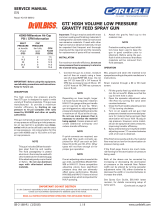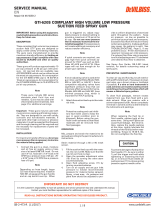Page is loading ...

Binks SV25 Spray Gun
DESCRIPTION
This gun is designed for spraying a variety of materials
and is ideal for working with small compressors in
workshops, homes, farms, schools, etc.
Gun is bleeder type, for use only with a pressure feed
metal cup directly attached to it using and air pressure
NOT OVER 40 PSI.
CLEANING
Unscrew cup (15) a little without removing it from gun.
Hold a clean cloth over air nozzle (11). Pull trigger (6)
and air pressure will force material back into cup.
Remove cup (15) from gun body. Empty material from
cup and add a small quantity of suitable clean solvent.
Replace cup on gun and spray in usual manner until clear
solvent appears and gun is thoroughly clean.
Remove cup from gun body again and clean the gasket
(13) of the cup lid. Loosen and remove the air cap (11)
and clean it with a soft brush.
Use a brush with solvent for cleaning inside the cup lid.
We recommend you clean your gun after each day’s use.
Wipe outside of gun with a solvent-soaked cloth.
LUBRICATION
At the end of each day’s use, place a drop of spray gun
lube (part no. SSL-10) at trigger bearing pin (5) and on
fluid needle packing (10). Never completely immerse gun
in solvent. This may damage packings and destroy gun
lubricants. Use proper tools (WR-103 wrench) when
removing parts to avoid damaging threads.
TECHNICAL SPECIFICATIONS
Air Inlet Threads: 1/4" NPS(M)
Air Consumption: 6.8 cfm @ 40 psi
5.0 cfm @ 30 psi
3.6 cfm @ 20 psi
Maximum Air Inlet
Pressure:
40 psi
Replaces
Part Sheet
77-2886
Part
Sheet
77-2886R

2
Warning
!
In this part sheet, the words WARNING, CAUTION and NOTE are used to emphasize important safety information as follows:
CAUTION
Hazards or unsafe practices which could
result in minor personal injury, product
or property damage.
!
WARNING
Hazards or unsafe practices which could
result in severe personal injury, death or
substantial property damage.
!
NOTE
Important installation, operation or
maintenance information.
Read the following warnings before using this equipment.
READ THE MANUAL
Before operating finishing equipment, read and
understand all safety, operation and maintenance
information provided in the operation manual.
AUTOMATIC EQUIPMENT
Automatic equipment may start suddenly without
warning.
INSPECT THE EQUIPMENT DAILY
Inspect the equipment for worn or broken parts
on a daily basis. Do not operate the equipment
if you are uncertain about its condition.
NEVER MODIFY THE EQUIPMENT
Do not modify the equipment unless the
manufacturer provides written approval.
KNOW WHERE AND HOW TO SHUT OFF THE
EQUIPMENT IN CASE OF AN EMERGENCY
PRESSURE RELIEF PROCEDURE
Always follow the pressure relief procedure in the
equipment instruction manual.
NOISE HAZARD
You may be injured by loud noise. Hearing
protection may be required when using this
equipment.
STATIC CHARGE
Fluid may develop a static charge that must be
dissipated through proper grounding of the
equipment, objects to be sprayed and all other
electrically conductive objects in the dispensing
area. Improper grounding or sparks can cause a
hazardous condition and result in fire, explosion
or electric shock and other serious injury.
FIRE AND EXPLOSION HAZARD
Never use 1,1,1-trichloroethane, methylene
chloride, other halogenated hydrocarbon solvents
or fluids containing such solvents in equipment
with aluminum wetted parts. Such use could
result in a serious chemical reaction, with the
possibility of explosion. Consult your fluid
suppliers to ensure that the fluids being used are
compatible with aluminum parts.
WEAR SAFETY GLASSES
Failure to wear safety glasses with side shields
could result in serious eye injury or blindness.
OPERATOR TRAINING
All personnel must be trained before operating
finishing equipment.
EQUIPMENT MISUSE HAZARD
Equipment misuse can cause the equip ment to
rupture, malfunction, or start unexpectedly and
result in serious injury.
KEEP EQUIPMENT GUARDS IN PLACE
Do not operate the equipment if the safety
devices have been removed.
PROJECTILE HAZARD
You may be injured by venting liquids or gases
that are released under pressure, or flying debris.
PINCH POINT HAZARD
Moving parts can crush and cut. Pinch points are
basically any areas where there are moving parts.
DE-ENERGIZE, DEPRESSURIZE, DISCONNECT
AND LOCK OUT ALL POWER SOURCES DURING
MAINTENANCE
Failure to De-energize, disconnect and lock out
all power supplies before performing equipment
maintenance could cause serious injury or death.
TOXIC FLUID & FUMES
Hazardous fluid or toxic fumes can cause serious
injury or death if splashed in the eyes or on the skin,
inhaled, injected or swallowed. LEARN and KNOW
the specific hazards of the fluids you are using.
WEAR RESPIRATOR
Toxic fumes can cause serious injury or death if
inhaled. Wear a respirator as recommended by
the fluid and solvent manufacturer’s Material
Safety Data Sheet.
FOR FURTHER SAFETY INFORMATION REGARDING BINKS AND DEVILBISS EQUIPMENT,
SEE THE GENERAL EQUIPMENT SAFETY BOOKLET (77-5300).
IT IS THE RESPONSIBILITY OF THE EMPLOYER TO PROVIDE THIS INFORMATION TO THE OPERATOR OF THE EQUIPMENT.
CA PROP
65
PROP 65 WARNING
WARNING: This product contains chemicals known
to the State of California to cause cancer and
birth defects or other reproductive harm.

3
BINKS SV25 INTERNAL MIX SPRAY GUN
SPRAY TECHNIQUE
The first requirement for a good resultant
finish is the proper handling of the gun.
The gun should be held perpendicular to
the surface being covered and moved
parallel with it. The stroke should be
started before the trigger is pulled and
the trigger should be released before the
stroke is ended. This gives accurate control
of the gun and fluid.
The distance between gun and surface
should be 6 to 12 inches depending on
fluid and atomizing pressure. The fluid
deposited should always be even and
wet. Lap each stroke over the preceding
stroke to obtain a uniform finish.
GENERAL SPRAY
INSTRUCTIONS
To reduce overspray and obtain maximum
efficiency, always spray with the lowest
possible air pressure that produces an
acceptable spray pattern.
Excessive atomizing air pressures can
increase overspray, reduce transfer effi-
ciency, and with some materials, result
in poor finish quality from dry spray.
SET-UP FOR SPRAYING
Connecting Gun To Air Hose
Air should be supplied by a suitable
length of 5/16" diameter air hose fitted
with a 1/4" NPS(f) connection at gun
end. For hose lengths over 50', use 3/8"
diameter hose.
Generally use 15-20 psi air at gun inlet.
Unusually heavy, difficult to atomize fluids
may require up to 40 psi air at gun inlet.
CONTROLLING THE FAN SPRAY
The fan spray is controlled by means
of the spray pattern valve. Turning this
control clockwise until it is closed will
give a round spray; turning it counter-
clockwise will widen the spray into a
fan shape. The fan spray can be turned
anywhere through 360 ° by positioning
the air nozzle relative to the gun.
To accomplish this, loosen retaining
ring, position nozzle, then tighten retain-
ing ring.
AIR NOZZLE, FLUID NOZZLE,
FLUID NEEDLE
1. All nozzles and needles are precision
made. They should be handled with
care.
2. Do not make any alterations in the
gun. To do so could cause finishing
difficulties.
3. To clean nozzles, soak them in solvent
to dissolve any dried material, then
blow them clean with air.
4. Do not probe any of the holes in the
nozzles with metal instruments.
If probing is necessary, use only a
tool that is softer than brass.
TROUBLESHOOTING
Faulty Spray
A faulty spray pattern is often caused
by improper cleaning resulting in dried
materials around the fluid nozzle tip
or in the air nozzle. Soak these parts in
thinners to soften the dried material
and remove with a brush or cloth.
If either the air nozzle or fluid nozzle are
damaged, spray pattern may be affected.
Intermittent Spray
If the spray flutters, it is caused by one
of the following faults:
1. Insufficient fluids available. Check
supply and replenish if necessary.
2. Insufficient fluid pressure from standard
pressure pots.
3. Fluid tip not tightened sufficiently.
NOTE
To reduce overspray and obtain
maximum efficiency always spray
with the lowest possible atomizing
air pressure.
CAUTION
Never use metal instruments to clean
the air or fluid nozzles. These parts
are carefully machined and any dam-
age to them will cause faulty spray.
!
CAUTION
Do not exceed 40 psi inlet pressure.
!
OPERATING THE SV25
SPRAY GUN
CAUTION
All parts on a spray gun should be
screwed in hand tight at first; this
will avoid the possibility of cross
threading the parts. If the parts
cannot be turned by hand easily,
make sure you have the correct
parts, unscrew, realign, and try
again. NEVER use undue force in
mating parts.
!

8
7
1 2 4
9
10
5
6
3 11 12
13
14
15
PARTS LIST
ITEM
NO. DESCRIPTION
1 Adjusting Screw
2 Fluid Needle Spring
3 Fluid Tip (1.5 mm)
4 Fluid Needle
5 Trigger Pin
6 Trigger
7 Air Connector
8 Gun Body
9 Needle Packing Nut
10 Needle Packing
11 Air Nozzle
12 Retaining Ring
13 Cup Gasket
14 Fluid Tube
15 Cup
BINKS SV25 INTERNAL MIX SPRAY GUN
CAUTION
Cup may remain pressurized after
trigger is released and air supply is
disconnected from gun.
!
2/13 ©2013 Binks All rights reserved. Printed in U.S.A.
U.S.A./Canada Customer Service
195 Internationale Blvd.
Glendale Heights, IL 60139
630-237-5000
Toll Free Customer Service
and Technical Support
800-992-4657
Toll Free Fax
888-246-5732
Binks Sales and Service: www.binks.com
WARRANTY
This product is covered by Binks’ 1 Year Limited Warranty.
77-2886R Revisions: Trademark updates;
(P2) Added Prop 65 warning;
(P4) Updated contact information.
/











